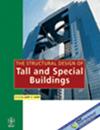Experimental and numerical investigations on large‐section rectangular CFT columns with distributive beam under axial compression
IF 1.3
3区 工程技术
Q3 CONSTRUCTION & BUILDING TECHNOLOGY
引用次数: 0
Abstract
In order to improve the co‐working performance between the core concrete and steel tube for large‐section rectangular concrete‐filled steel tubular (LSCFT) columns when a vertical load is directly applied to the steel tube, a distributive beam is proposed as a load transferring measure. Four scaled LSCFT column specimens with different details were tested under axial compression to investigate the mechanical behavior and load transferring mechanism of the LSCFT columns with a distributive beam. The experimental results indicated that the bearing capacity of the LSCFT columns without a distributive beam was close to the yield capacity of the steel tube and the load shared by the core concrete was negligible. In contrast, the specimen with a distributive beam and inner stiffeners could bear a much higher load. In addition, refined nonlinear finite element models were developed to further analyze the load‐transferring mechanism of LSCFT columns with different details. The numerical results showed that the ultimate load of the specimen with a distributive beam and inner stiffeners was much closer to the theoretical value calculated from Chinese code CECS159:2004. Setting a distributive beam and inner stiffeners simultaneously in LSCFT columns could ensure the cooperation between the core concrete and steel tube.轴压作用下带分布梁的大截面矩形CFT柱的试验与数值研究
为了提高大截面矩形钢管混凝土柱在竖向荷载直接作用于钢管时核心混凝土与钢管的协同工作性能,提出了一种分配梁作为荷载传递措施。对四个不同细节的LSCFT柱试件进行了轴压试验,研究了配梁LSCFT的受力性能和荷载传递机理。试验结果表明,无分配梁的LSCFT柱的承载力接近钢管的屈服承载力,核心混凝土分担的荷载可以忽略不计。相反,具有分配梁和内部加劲肋的试样可以承受更高的载荷。此外,还开发了精细的非线性有限元模型,以进一步分析不同细节的LSCFT柱的荷载传递机制。数值计算结果表明,具有分布梁和内部加劲肋的试件的极限载荷与中国规范CECS159:2004计算的理论值非常接近。在LSCFT柱中同时设置分配梁和内部加劲肋,可以保证核心混凝土和钢管之间的配合。
本文章由计算机程序翻译,如有差异,请以英文原文为准。
求助全文
约1分钟内获得全文
求助全文
来源期刊
CiteScore
5.30
自引率
4.20%
发文量
83
审稿时长
6-12 weeks
期刊介绍:
The Structural Design of Tall and Special Buildings provides structural engineers and contractors with a detailed written presentation of innovative structural engineering and construction practices for tall and special buildings. It also presents applied research on new materials or analysis methods that can directly benefit structural engineers involved in the design of tall and special buildings. The editor''s policy is to maintain a reasonable balance between papers from design engineers and from research workers so that the Journal will be useful to both groups. The problems in this field and their solutions are international in character and require a knowledge of several traditional disciplines and the Journal will reflect this.
The main subject of the Journal is the structural design and construction of tall and special buildings. The basic definition of a tall building, in the context of the Journal audience, is a structure that is equal to or greater than 50 meters (165 feet) in height, or 14 stories or greater. A special building is one with unique architectural or structural characteristics.
However, manuscripts dealing with chimneys, water towers, silos, cooling towers, and pools will generally not be considered for review. The journal will present papers on new innovative structural systems, materials and methods of analysis.

 求助内容:
求助内容: 应助结果提醒方式:
应助结果提醒方式:


